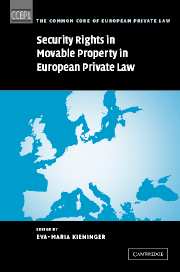Book contents
- Frontmatter
- Contents
- General editors' preface
- Preface
- List of contributors
- Table of cases cited by name
- Table of legislation
- Part I Introduction and context
- Part II The case studies
- List of abbreviations
- Bibliographies
- Glossary
- Case 1 Furniture for a new office
- Case 2 The deceived seller
- Case 3 Machinery supplied to be used by the buyer
- Case 4 Jackets for resale
- Case 5 Motor cars supplied and resold (I)
- Case 6 Motor cars supplied and resold (II)
- Case 7 Supply of material to manufacturer (I)
- Case 8 Supply of material to manufacturer (II)
- Case 9 Too many toasters
- Case 10 Bank loan on the basis of a car fleet
- Case 11 Bank loan for a wholesaler
- Case 12 Bank loan on the basis of money claims (I)
- Case 13 Bank loan on the basis of money claims (II)
- Case 14 Finance leasing of computers
- Case 15 Indebted businessman sells business to brother
- Evaluation: a common core? Convergences, subsisting differences and possible ways for harmonisation
- Index by country
- Index by subject
Evaluation: a common core? Convergences, subsisting differences and possible ways for harmonisation
Published online by Cambridge University Press: 23 December 2009
- Frontmatter
- Contents
- General editors' preface
- Preface
- List of contributors
- Table of cases cited by name
- Table of legislation
- Part I Introduction and context
- Part II The case studies
- List of abbreviations
- Bibliographies
- Glossary
- Case 1 Furniture for a new office
- Case 2 The deceived seller
- Case 3 Machinery supplied to be used by the buyer
- Case 4 Jackets for resale
- Case 5 Motor cars supplied and resold (I)
- Case 6 Motor cars supplied and resold (II)
- Case 7 Supply of material to manufacturer (I)
- Case 8 Supply of material to manufacturer (II)
- Case 9 Too many toasters
- Case 10 Bank loan on the basis of a car fleet
- Case 11 Bank loan for a wholesaler
- Case 12 Bank loan on the basis of money claims (I)
- Case 13 Bank loan on the basis of money claims (II)
- Case 14 Finance leasing of computers
- Case 15 Indebted businessman sells business to brother
- Evaluation: a common core? Convergences, subsisting differences and possible ways for harmonisation
- Index by country
- Index by subject
Summary
Each of the fifteen cases has been concluded with comparative observations trying to take stock of the national solutions and to find reasons for at least some of the differences. The purpose of the present evaluation is neither to present a summary of these comparisons nor to give another overview of the law relating to security rights in the different jurisdictions under consideration. Rather, these final remarks aim at drawing a few more general conclusions in view of the need for some measure of European harmonisation that has been identified in the Introduction. Therefore, I will seek to identify common tendencies as well as subsisting differences both with respect to general principles and in relation to specific security devices. The evaluation will conclude with some suggestions as to possible ways for harmonisation.
General tendencies
Common developments
Evolution of secured transactions law outside the Civil Codes
A first, very general, but nonetheless significant common element lies in the fact that the development of secured transactions law on the Continent largely took place (and continues to take place) outside the national Civil Codes.
- Type
- Chapter
- Information
- Security Rights in Movable Property in European Private Law , pp. 647 - 673Publisher: Cambridge University PressPrint publication year: 2004
- 1
- Cited by



